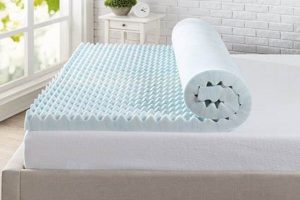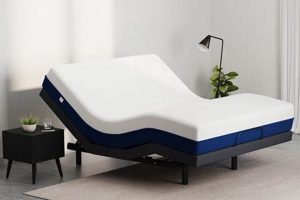An inflatable sleeping surface with variable firmness control offers customized comfort. These beds allow users to modify the internal air pressure to achieve a desired level of support, ranging from soft and plush to firm and rigid. For example, an individual with back pain may prefer a firmer setting for spinal alignment, while another may desire a softer surface for pressure relief.
The ability to tailor sleep surface firmness offers significant advantages. Adjustability caters to diverse comfort preferences and accommodates changing needs, such as pregnancy or recovery from injury. Historically, air mattresses were primarily used for temporary sleeping arrangements; however, advanced materials and adjustable features have elevated them to viable long-term bedding solutions. These innovations have addressed concerns about support and durability, enhancing overall sleep quality.
This article will explore the key features, materials, and construction considerations relevant to these sleep solutions. It will also discuss factors that differentiate products and contribute to user satisfaction, as well as offering considerations regarding longevity and maintainence.
Tips on Optimizing a Variable Firmness Inflatable Bed
Maximizing the advantages of an inflatable bed with adjustable firmness requires careful attention to several factors. Adherence to the following guidelines can enhance comfort, prolong lifespan, and ensure optimal performance.
Tip 1: Understand the Adjustment Range: Familiarize yourself with the specific pressure settings offered by the bed. Experiment with incremental adjustments to identify the firmness level that provides adequate support and pressure relief.
Tip 2: Monitor Inflation Levels: Regularly check the bed’s inflation to maintain the desired firmness. Temperature fluctuations can affect air pressure; therefore, periodic adjustments may be necessary.
Tip 3: Utilize Protective Bedding: Employ a mattress protector to shield the bed’s surface from punctures, spills, and dust. This will extend its lifespan and maintain hygiene.
Tip 4: Ensure Proper Placement: Position the bed on a level surface free from sharp objects. Uneven surfaces can strain the internal seams and compromise the bed’s structural integrity.
Tip 5: Distribute Weight Evenly: Avoid concentrating excessive weight in a single area. Distributing weight across the entire surface helps to prevent localized stress and potential damage.
Tip 6: Adhere to Weight Limits: Observe the manufacturer’s specified weight limit to prevent over-inflation and potential rupture of the internal bladders.
Tip 7: Check for Leaks: Inspect the seams and valve for potential leaks regularly. Addressing leaks promptly can prevent significant air loss and maintain the desired firmness.
By implementing these strategies, individuals can optimize the comfort and durability of their variable firmness inflatable bed, ensuring a restful and supportive sleep experience.
The subsequent sections of this document will elaborate on specific product features and comparative analyses, providing a comprehensive overview of available options.
1. Firmness Customization Range
Firmness Customization Range is a pivotal attribute in determining the suitability of an adjustable air mattress. It directly relates to the degree of personalized comfort achievable, dictating the mattress’s versatility in accommodating diverse sleeping preferences and physical needs. A wider range offers greater adaptability, making the mattress more likely to satisfy a broader spectrum of users.
- Pressure Increment Granularity
The granularity of pressure adjustments significantly impacts the precision of comfort calibration. Mattresses with fine-tuned increment control, such as those offering adjustments in 0.1 PSI increments, enable users to achieve a more precise level of firmness compared to models with coarser settings. This granularity is especially crucial for individuals with specific support requirements or sensitivities to pressure points.
- Upper and Lower Firmness Limits
The extreme ends of the adjustment spectrum define the boundaries of achievable comfort. A wider range, from very soft to exceptionally firm, allows the mattress to accommodate a greater variety of sleeping positions and body weights. For instance, a mattress with a low-end setting suitable for side sleepers and a high-end firmness capable of supporting heavier individuals offers increased adaptability. The actual level of support the user can achieve must be a serious consideration.
- Consistency Across Zones
In dual-chambered models, consistent firmness control across separate zones is paramount. Variations in firmness between zones can disrupt sleep quality and lead to discomfort. A high-quality adjustable air mattress ensures that each zone responds predictably and consistently to adjustments, maintaining a uniform level of support across the entire sleeping surface. A discrepancy in firmness can create uneven support.
- Digital vs. Manual Control
The control mechanism influences the user experience. Digital controls offer precise and repeatable adjustments, often with preset comfort levels. Manual controls may provide a more tactile experience but can lack the precision of digital systems. The reliability and accuracy of the control system are crucial for maintaining the desired firmness over time.
A comprehensive assessment of the firmness customization range, encompassing pressure granularity, upper and lower limits, consistency across zones, and the type of control system, is essential when evaluating the suitability of an adjustable air mattress. These factors collectively determine the mattress’s ability to provide personalized comfort and support, significantly impacting the overall sleep experience.
2. Material Durability
Material durability is a foundational element in the overall performance and longevity of an adjustable air mattress. The materials used in construction directly impact the mattress’s ability to withstand internal pressure, resist punctures, and maintain its structural integrity over extended use. Consequently, a robust material composition is a critical factor in differentiating a reliable product from a substandard one.
- Outer Shell Composition
The outer shell is the first line of defense against external damage. Materials such as reinforced PVC, laminated fabrics, and high-denier nylon offer varying degrees of puncture resistance and abrasion protection. Mattresses intended for frequent use or outdoor applications should prioritize durable outer shell materials to prevent leaks and maintain air retention.
A tear in the outer shell compromises the entire structure. - Internal Bladder Construction
Internal bladders, responsible for containing and distributing air, are subject to constant stress from inflation and deflation cycles. Materials such as vulcanized rubber or multi-layer polymer films provide enhanced flexibility and resistance to cracking or seam separation. Welded seams, as opposed to glued seams, offer superior air tightness and prevent air leakage, ensuring consistent firmness over time. Construction is of the utmost importance to a high-quality product.
- Pump Housing and Components
The durability of the integrated pump is often overlooked but essential for convenient and reliable inflation. The pump housing should be constructed from impact-resistant materials to withstand accidental bumps or drops. Internal components, such as the motor and valve system, should be designed for longevity and require minimal maintenance. A malfunctioning pump renders the adjustability feature useless. It should be noted the ease of operation is essential.
- Seam Reinforcement Techniques
Seams are inherently weak points in inflatable structures. Advanced reinforcement techniques, such as multi-stitched seams, reinforced taping, and heat welding, can significantly improve seam strength and prevent air leakage. Seam quality is especially critical in high-stress areas, such as corners and edges, where the mattress is subjected to greater strain. Seam bursting is a common failure point in lower quality mattresses.
The interplay of these material-related factors dictates the overall lifespan and reliability of an adjustable air mattress. Selection should prioritize mattresses constructed from robust materials and employing advanced manufacturing techniques to ensure long-term durability and consistent performance.
3. Support System Integrity
Support system integrity, with respect to adjustable air mattresses, refers to the ability of the internal structure to maintain a consistent and uniform distribution of weight and pressure, regardless of the selected firmness level. A high level of integrity ensures that the mattress provides adequate spinal alignment and minimizes pressure points, thereby contributing significantly to sleep quality. A compromised support system can lead to uneven weight distribution, localized sagging, and ultimately, discomfort or even pain. For example, an air mattress with inadequate internal baffling may exhibit bulging in certain areas when inflated, creating an unstable and unsupportive sleeping surface. This underscores the crucial role of robust internal construction in achieving a comfortable and restorative sleep experience.
The design of the internal support system varies among different models. Some mattresses utilize interconnected air chambers, while others employ I-beam or coil-beam construction. I-beam construction, for example, uses vertical beams of material to connect the top and bottom surfaces of the air bladder, providing enhanced stability and preventing excessive sagging. Coil-beam construction mimics the support characteristics of traditional innerspring mattresses, offering a more familiar feel. Regardless of the specific design, the key objective is to ensure that the mattress provides consistent support across the entire sleeping surface, even under varying weight loads and firmness settings. A failure to maintain this consistency undermines the mattress’s adjustability feature and can negate its potential benefits.
In summary, support system integrity is a fundamental attribute of a high-quality adjustable air mattress. It directly impacts comfort, spinal alignment, and overall sleep quality. Understanding the different design approaches used to enhance support system integrity is crucial for consumers seeking a durable and effective adjustable air mattress. Choosing a mattress with a well-engineered support system is an investment in long-term sleep health and well-being. In choosing the correct mattress it should be an individuals goal to prioritize the best support they can find.
4. Inflation/Deflation Speed
Inflation and deflation speed represents a crucial convenience factor in adjustable air mattresses. The time required to inflate a mattress to its operational firmness or deflate it for storage directly impacts the user experience. A rapid inflation/deflation cycle minimizes setup time, making the mattress more practical for temporary sleeping arrangements or situations where quick deployment is necessary. Conversely, a slow cycle can be inconvenient and detract from the overall usability, particularly in time-sensitive scenarios. Air leakage or slow inflation would hinder the usability of this technology. The speed should be a major consideration.
Consider a scenario where guests arrive unexpectedly. An adjustable air mattress with rapid inflation allows hosts to quickly provide a comfortable sleeping space without lengthy preparation. Conversely, imagine needing to quickly deflate a mattress to clear space in a room; a slow deflation process can be cumbersome and time-consuming. Therefore, the integration of a high-performance pump and valve system is essential for achieving optimal inflation and deflation speeds. Moreover, the effectiveness of these systems can also correlate to how simple or difficult it is to adjust the bed firmness to the user’s liking. Simple features can also make this more accessible.
In conclusion, inflation and deflation speed significantly contribute to the overall value and practicality of adjustable air mattresses. While not directly related to support or comfort, these factors enhance user convenience and contribute to a more positive ownership experience. Manufacturers who prioritize efficient inflation/deflation mechanisms demonstrate a commitment to user-centric design and enhance the appeal of their products in a competitive market. Optimizing these will also optimize the experience.
5. User Feedback Consistency
User feedback consistency serves as a critical indicator of the reliability and overall satisfaction associated with an adjustable air mattress. Consistent positive feedback across a substantial user base suggests that the product performs as advertised and effectively meets the needs of a diverse range of individuals. Conversely, inconsistent or predominantly negative feedback raises concerns regarding the product’s quality, durability, or ability to deliver the advertised benefits. The consistency, therefore, provides a valuable metric for assessing the overall performance and potential satisfaction a consumer might experience.
The practical significance of user feedback consistency lies in its ability to inform purchasing decisions and mitigate the risks associated with acquiring a potentially subpar product. For example, if a particular adjustable air mattress receives consistently high ratings across various online platforms and review sites, with users praising its adjustability, comfort, and durability, it suggests that the product is likely to provide a positive ownership experience. However, if feedback is mixed, with some users reporti
ng excellent results while others describe significant issues such as air leaks, uneven support, or pump malfunctions, it warrants further investigation and caution. Furthermore, the volume of feedback must also be considered; a small sample size may not accurately reflect the true performance of the mattress. For example, a mattress with only a few dozen reviews, even if overwhelmingly positive, may not be as reliable of a predictor as a mattress with hundreds or thousands of reviews demonstrating consistently high satisfaction.
In conclusion, user feedback consistency is a vital component of evaluating an adjustable air mattress. It provides a comprehensive assessment of the product’s reliability, performance, and potential for user satisfaction. While no single metric should dictate a purchasing decision, consistent positive feedback serves as a strong indicator of a product’s quality and can significantly reduce the risk of buyer’s remorse. Consumers should carefully analyze user reviews across multiple platforms to determine if the experiences are consistent enough to warrant confidence in the product’s ability to meet their individual needs and expectations. Ultimately, the feedback should align with the individual needs of the user.
Frequently Asked Questions
This section addresses common inquiries regarding inflatable sleeping solutions featuring adjustable firmness. The information provided aims to offer clarity and assist in informed decision-making.
Question 1: How does the adjustability feature function in an air mattress?
The adjustability feature operates through an integrated pump system that controls the air pressure within the mattress. This allows users to increase or decrease the firmness level to achieve a desired degree of support.
Question 2: What factors influence the overall durability of an inflatable bed?
Durability is primarily determined by the materials used in construction. Reinforced outer shells, robust internal bladders, and reinforced seams contribute to a product’s longevity.
Question 3: Can these mattresses be used as a primary long-term sleeping solution?
While initially designed for temporary use, advancements in materials and construction have made some models suitable for long-term use. However, users should consider factors such as support, spinal alignment, and potential for air leakage.
Question 4: What are the advantages of dual-chambered designs in adjustable air mattresses?
Dual-chambered designs enable independent firmness adjustments on each side of the mattress. This caters to individuals with differing sleep preferences or support requirements.
Question 5: How should one properly maintain an adjustable air mattress to extend its lifespan?
Maintenance involves regular inspection for leaks, using a mattress protector, avoiding sharp objects, and adhering to the manufacturer’s specified weight limits.
Question 6: What should one consider when assessing user reviews before purchasing a product?
Focus on the consistency of feedback across multiple platforms. Note recurring themes regarding comfort, durability, and potential issues. A larger sample size generally provides a more accurate representation of product performance.
Careful consideration of these factors will assist in selecting a suitable inflatable bed. Understanding its features and limitations will contribute to long-term satisfaction.
The subsequent article section will discuss comparative analysis of specific products currently available.
Conclusion
The preceding analysis has elucidated critical factors impacting the selection of a best adjustable air mattress. Consideration of firmness customization range, material durability, support system integrity, inflation/deflation speed, and user feedback consistency remains paramount. Each attribute contributes significantly to the overall performance, longevity, and user satisfaction associated with these products. Failure to adequately assess these features may result in diminished sleep quality and premature product failure.
The market for inflatable sleeping solutions continues to evolve, with manufacturers striving to enhance comfort, durability, and convenience. Continued research and development in materials science and engineering will likely lead to further improvements in these products. Prudent consumers should remain informed about advancements and exercise diligence in their evaluation process to secure a sleeping surface that meets their individual needs and delivers lasting value. A thoroughly considered purchase is essential for optimal sleep and long-term satisfaction.





![Top-Rated Best Folding Cot with Mattress [2024 Guide] Organic & Natural Mattress Buyer’s Guide: Non-Toxic Sleep Solutions Top-Rated Best Folding Cot with Mattress [2024 Guide] | Organic & Natural Mattress Buyer’s Guide: Non-Toxic Sleep Solutions](https://mattressworldpa.com/wp-content/uploads/2025/07/th-7613-300x200.jpg)
![Top-Rated Best Mattress for Pack N Play - [Year] Review Organic & Natural Mattress Buyer’s Guide: Non-Toxic Sleep Solutions Top-Rated Best Mattress for Pack N Play - [Year] Review | Organic & Natural Mattress Buyer’s Guide: Non-Toxic Sleep Solutions](https://mattressworldpa.com/wp-content/uploads/2025/07/th-7612-300x200.jpg)
